| |
| Insects: mosquitos, flies and gnats |
Asian Tiger Mosquito (Aedes albopictus)
House Mosquito (Culex quinquefasciatus)
House Mosquito (Culex restuans)
Crane fly (Tipulidae sp.)
House Fly (Musca domestica)
Fly ( ) ?
Sarcophaga Fly (Sarcophaga sp.)
*Small Black Fly (Gabaza albiseta) ?
*Tiny Black Fly ( ) ?
*Stripe Fly ( ) ?
*Stripe Fly 2 ( ) ?
Eristalinus Syrphid Fly (Eristalinus arvorum) ?
Muscedae Fly ( ) ?
Vinegar Fly (Drosophila melanogaster)
Vinegar Fly (Drosophila hydei) ?
*Spot-wing Vinegar Fly (Leucophenga maculosa)
Black Soldier Fly (Hermetia illuscens)
*Spot-wing Soldier Fly (Evaza javanensis)
Crane Fly (Limonia perkinsi)
*Clearwing Crane Fly ( ) ?
Mosquito Eater (Tipula oropezoides) ?
*Grey Crane Fly ( ) ?
Picture wing Fly (Euxesta annonae)
*Fly_01 ( ) ?
*White Gnat ( ) ?
Gull Midge ( ) ?
Midge (Chironomus hawaiiensis) ?
Brown Lacewing (Hemerobius pacificus)
Green Lacewing (Chrysoperla comanche)
Green Lacewing larva (Chrysoperla comanche)
Greenhouse Whitefly (Trialeurodes vaporariorum) ?
*Humpback Fly ( ) ?
Mothmidge (Clogmia albipunctata)
Dark-winged Fungus Gnat (Sciara sp.)
*Little Green Fly ( ) ?
*Red Eye Two Stripe Fly (Lauxanidae sp.)
*Cross-stripe Fly (Anthomyia vicarians)
*Stripe-wing Fly (Euxesta stigmatias)
*Black-back Fly ( ) ?
*Fat Body Fly (Megaselia sp.)
*Grey Fly ( ) ?
Yellow Hoverfly (Allograpta obliqua)
Oriental Fruit Fly (Bactrocera dorsalis)
Wasp Mimic (Taeniaptera angulata)
Biting Midge (Dasyhelea sp.)
Names preceded by an asterisk indicate common names that I have made up.
|
Asian Tiger Mosquito
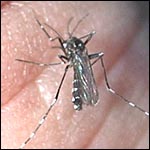 |
|
|
|
|
| |
|
|
|
|
 |
This is a day biting mosquito. Hawaii was mosquito free before 1826, when the night biting mosquito arrived. The day-biting mosquitoes reached the islands around 1892-1897. |
House Mosquito
(Culex quinquefasciatus)
 |
A common mosquito in Hawaii and is bigger than the Tiger Mosquito. It's a night biter and the most effective vector of West Nile virus.
[Species identification made by Nieu Nguyen and Cyntiha Harrison of the New Orleans Mosquito Control program.] |
Mosquito (Culex restuans)
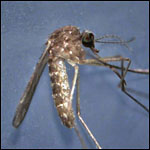 |
Body length = 3mm. |
| |
|
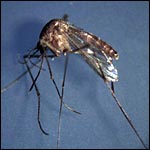 |
Mosquito body length about 4 mm. |
Crane Fly
House Fly
Fly
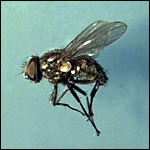 |
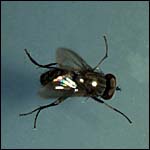 |
This fly is 5 mm long. It hovers with others in small groups. |
Sarcophaga Fly
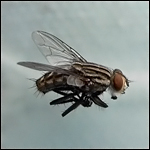 |
This fly has a body length of 12mm.
ID by Frank Howarth of the Bishop Museum. |
Small Black Fly
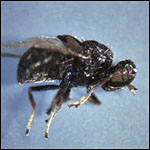 |
Side. |
| |
|
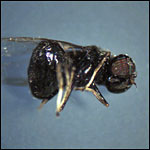 |
Ventral. Body length = 3 mm. Identification made by Dr. Norman Woodley, National Museum of Natural History. |
Tiny Black Fly
 |
This fly is about 2 mm long. |
Stripe Fly
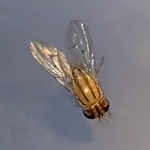 |
 |
This fly is about 5 mm long. |
Stripe Fly (type 2)
 |
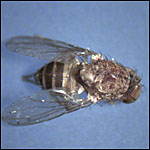 |
(Immediate left) Dorsal view. Fly length = 3 mm. |
Eristalinus Syrphid Fly
 |
Dorsal view. |
| |
|
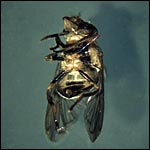 |
Ventral view. Note protrusion from lower jaw! Body length about 1 cm. |
Muscedae Fly
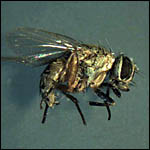 |
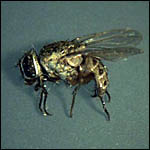 |
Body length = 4 mm. Identification made by Dr. Martin Hauser, California Department of Food and Agriculture. |
Vinegar Fly (D. melanogaster)
Vinegar Fly (D. hydei)
Spot-wing Vinegar Fly
 |
Side view. Body length = 3 mm. |
| |
|
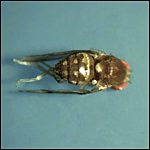 |
Dorsal view. This is an introduced species. |
Black Soldier Fly
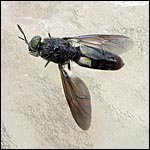 |
This fly is about 1.5 cm long. Identification made by Dr. Martin Hauser, California Department of Food and Agriculture. The soldier fly was first seen in 1930 in the fields of the Hilo Sugar Co.; now it is found on all of the major Hawaiian islands. |
Spot-wing Soldier Fly
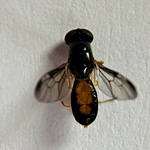 |
Body length is 6 mm.
Two black spots on clear wings and yellow patch on dorsal side of abdomen. This fly is a member of the Stratiomyidae family. Species identification by Norm Woodley at the USDA Systematic Entomology Laboratory. |
| |
|
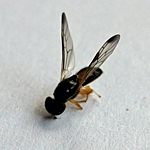 |
|
| |
|
Crane Fly
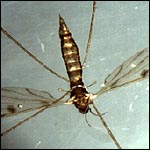 |
Body length = 5mm; leg length = 15mm.
Per David Preston at the Bishop Museum “It is a very common lowland crane fly species. It is an immigrant recorded from the Marquesas, Fiji, Tahiti and Samoa. The species can be recognized by the strongly arched vein R3, and broad black apices of the femora. It breeds in tree holes, leaf axils, and decaying vegetation.” |
Clearwing Crane Fly
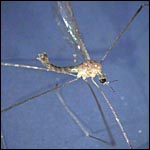 |
Body length = 4mm. There are no spots on the wings. |
Mosquito Eater (a large Crane Fly)
 |
Body length = 1cm, leg length = 4 cm. This is a Tipulidae, possibly Tipula oropezoides.
Despite the common name “mosquito eater” adult crane flies feed on nectar or they do not feed at all; most crane fly species live only to mate and die once they become adults. |
Grey Crane Fly
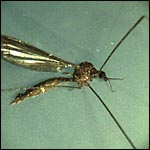 |
Body length = 1 cm, leg length = 2.5 cm. |
Picture Wing Fly
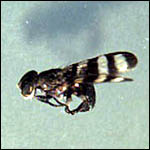 |
 |
Fly body length = 4mm.
Bishop Museum says: the fly is Euxesta annonae (Fabricius, 1794), a picture-winged ottitid fly. |
Fly_01
White Gnat
 |
Body length = 2 mm. |
Gull Midge
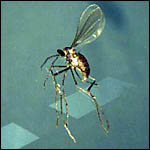 |
Body length about 1 mm. Identification made by Dr. Martin Hauser, California Department of Food and Agriculture. |
Midge
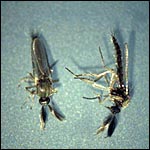 |
Body length 2 mm. These midges fly in small swarms. This is probably the endemic species Chironomus hawaiiensis. |
Brown Lacewing
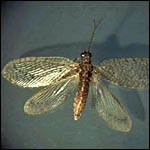 |
Dorsal view. |
| |
|
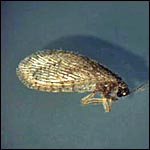 |
Side view. |
| |
|
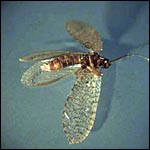 |
Ventral view. Body length about 7 mm. This may also called “Nesomicromus vagus” in the book by Howarth and Mull (Hawaiian Insects and their Kin) and is endemic on all major Hawaiian islands. |
Green Lacewing
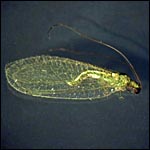 |
Side view. Body length, 6 mm. |
| |
|
 |
Closer view of large eye. |
Green Lacewing larva
Greenhouse Whitefly
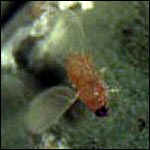 |
|
| |
|
 |
Fly on leaf. Fly body about 0.5 mm long. |
| |
|
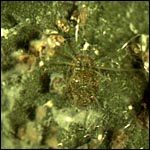 |
Whitefly pupa with long glassy setae on the dorsal surface. |
Humpback Fly
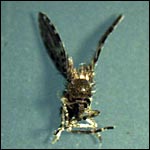 |
Front view. Height = 3mm. |
| |
|
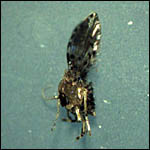 |
Side view. Length = 1.5 mm. |
Mothmidge
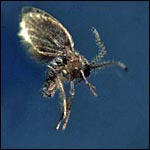 |
|
| |
|
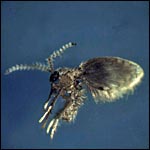 |
Body length about 3 mm.
Per Frank Howarth of the Bishop Museum: “It’s a moth fly, family Psychodidae; the species is Clogmia albipunctata (Williston, 1893). The larvae of this species are scavengers in highly polluted damp to aquatic habitats and are sometimes common in Hawaiian homes where they live in sink drains. The species has been introduced worldwide by humans. They are harmless to humans.” Note: this specimen caught outside near a fish pot with water plant. |
Dark-winged Fungus Gnat
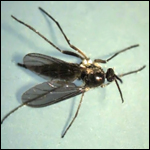 |
Dorsal. |
| |
|
 |
Side. |
Little Green Fly
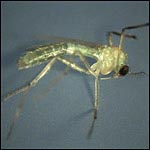 |
Ventral view. |
| |
|
 |
Dorsal view. Fly is a bit over 3 mm long. |
Red Eye Two Stripe Fly
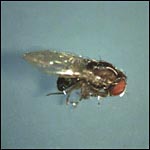 |
Side view. |
| |
|
 |
Dorsal view. Body length is 2 mm. Identification made by Dr. Martin Hauser, California Department of Food and Agriculture. |
Cross-stripe Fly
Stripe-wing Fly
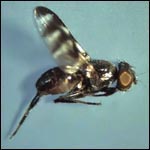 |
|
| |
|
 |
This fly is 3 mm long. It is probably a type of picture wing fly (Euxesta sp.) |
Black-back Fly
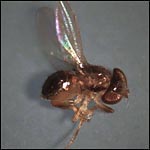 |
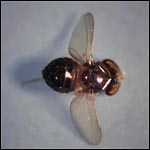 |
This fly is 2 mm long. |
Fat Body Fly
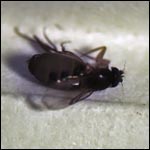 |
 |
Body is 3 mm long. |
Grey Fly
 |
 |
This fly is 2 mm long. |
Yellow Hoverfly (aka Syrphid Fly)
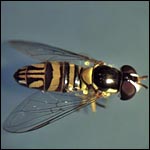 |
 |
Body length is 12 mm. |
Oriental Fruit Fly
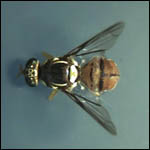 |
Dorsal view. |
| |
|
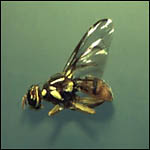 |
Side view. Body length is 7 mm. Per David Preston of the Bishop Muesum “This is the oriental fruit fly Bactrocera dorsalis (Hendel) which attacks over 300 cultivated and wild fruits including Annona (cherimoya, atemoya, sugar apple), avocado, banana, bittermelon, citrus, coffee, guava, macadamia, mango, papaya, passion fruit, peppers, persimmon, and tomato. Accidentally introduced into Hawaii in 1944 or 1945 (Fullaway, 1947).” |
Wasp Mimic
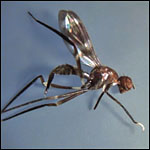 |
Body length is about 1 cm. |
| |
|
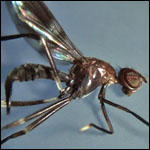 |
Per Frank Howarth of the Bishop Museum: “the animal is a true fly, order Diptera, not a wasp, but the species has evolved to fool potential predators. The species is Taeniaptera angulata (Loew, 1866), family Micropezidae, “the stilt-legged flies.” It’s a relatively recent introduction to Hawaii. The larvae live in damp rotting fleshy plant material, such as rotting sugar cane.” |
Biting Midge
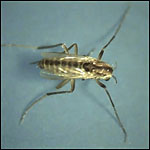 |
. |
| |
|
 |
Body length is 2 mm.
ID by David Preston of the Bishop Museum. |
|
|